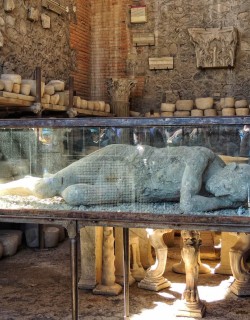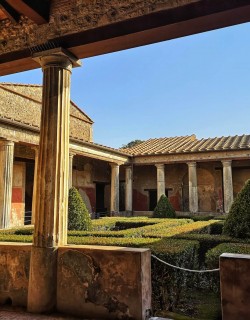“Stand at the bottom of the great market-place of Pompeii, and look up the silent streets, through the ruined temples of Jupiter and Isis, over the broken houses with their inmost sanctuaries open to the day, away to Mount Vesuvius, bright and snowy in the peaceful distance; and lose all count of time, and heed of other things, in the strange and melancholy sensation of seeing the Destroyed and the Destroyer making this quiet picture in the sun…”
Few authors have captured the strange yet beautiful melancholy of the fascinating ruins of Pompeii better than Charles Dickens. Dickens’ portrait of a city made up of “a series of faint reflections,” richly evocative traces of lives lived long ago, perfectly captures what makes visiting Pompeii so special. Vesuvius’ deadly volcanic eruption in 79AD paradoxically preserved the city in an extraordinary state of preservation even as it wiped out its inhabitants in an instant, and walking through the incredibly intact streets today is like stepping back in time to the heyday of the Roman world. Here, like nowhere else, the ghosts of antiquity seem still to speak to us across the centuries.
To help you plan your visit to this city frozen in time, read on for our illustrated guide to what you need to look out for amongst the maze of ruins!
The Plaster Casts
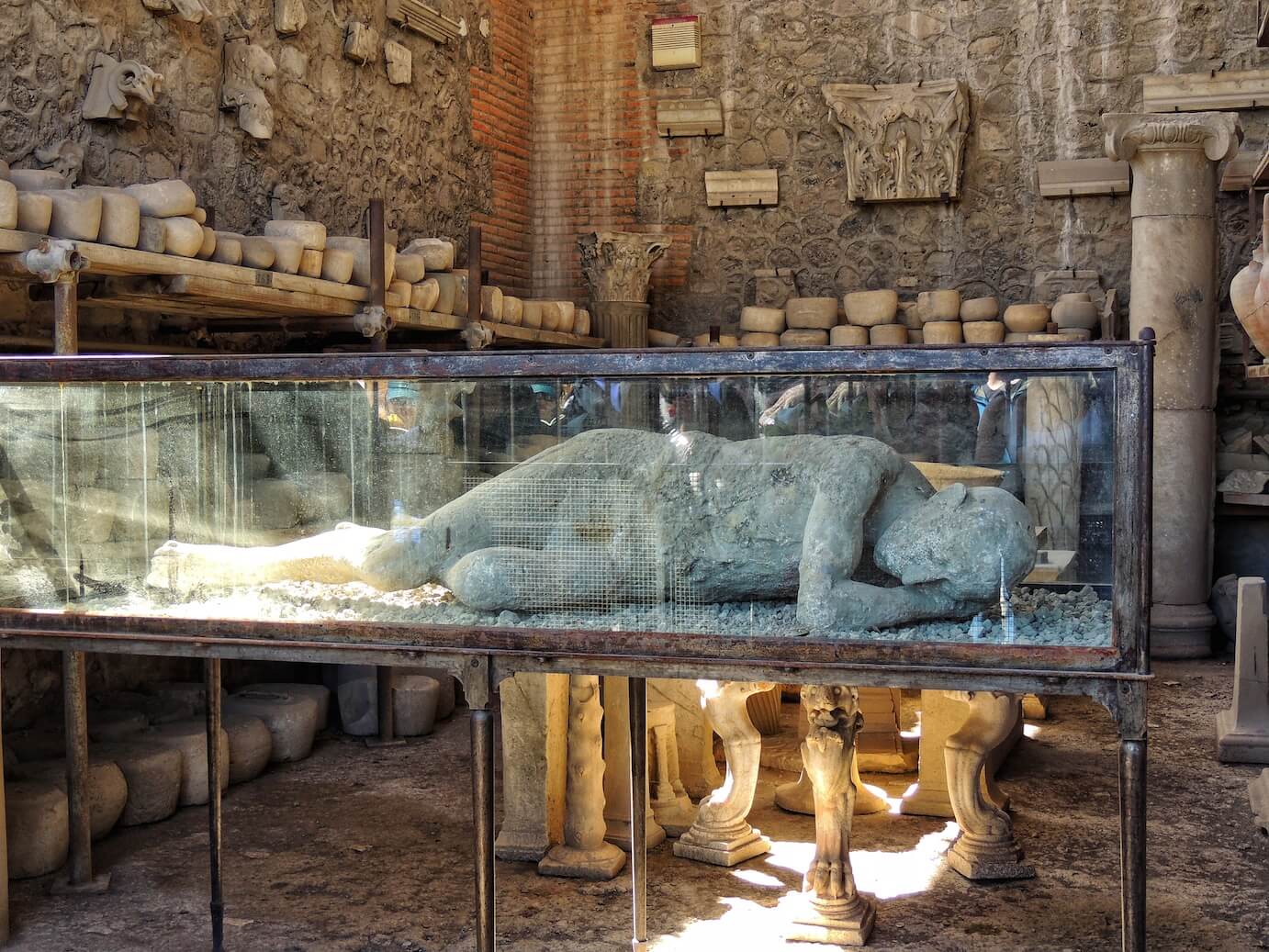 It’s important to remember that the eruption of Vesuvius that eerily preserved the buildings of Pompeii in its protective casing of ash was a human tragedy of horrifying scale for the desperate citizens that perished beneath the molten mud and choking clouds. Giving human faces to the distant event, the famous plaster casts of Pompeii immortalise the final moments of the city’s doomed populace. The bodies buried in the ash left cavities in the volcanic layer, and in the 1870s a method was devised to fill the gaps with liquid plaster. When it solidified, the forms of people and animals emerged from the earth in the exact poses in which they breathed their last. The casts are on display in various sites across the archaeological site: make sure to visit the Horrea (granary), where a dog trapped by the eruption struggles in vain to escape.
It’s important to remember that the eruption of Vesuvius that eerily preserved the buildings of Pompeii in its protective casing of ash was a human tragedy of horrifying scale for the desperate citizens that perished beneath the molten mud and choking clouds. Giving human faces to the distant event, the famous plaster casts of Pompeii immortalise the final moments of the city’s doomed populace. The bodies buried in the ash left cavities in the volcanic layer, and in the 1870s a method was devised to fill the gaps with liquid plaster. When it solidified, the forms of people and animals emerged from the earth in the exact poses in which they breathed their last. The casts are on display in various sites across the archaeological site: make sure to visit the Horrea (granary), where a dog trapped by the eruption struggles in vain to escape.
The Stabian Baths and Forum Baths
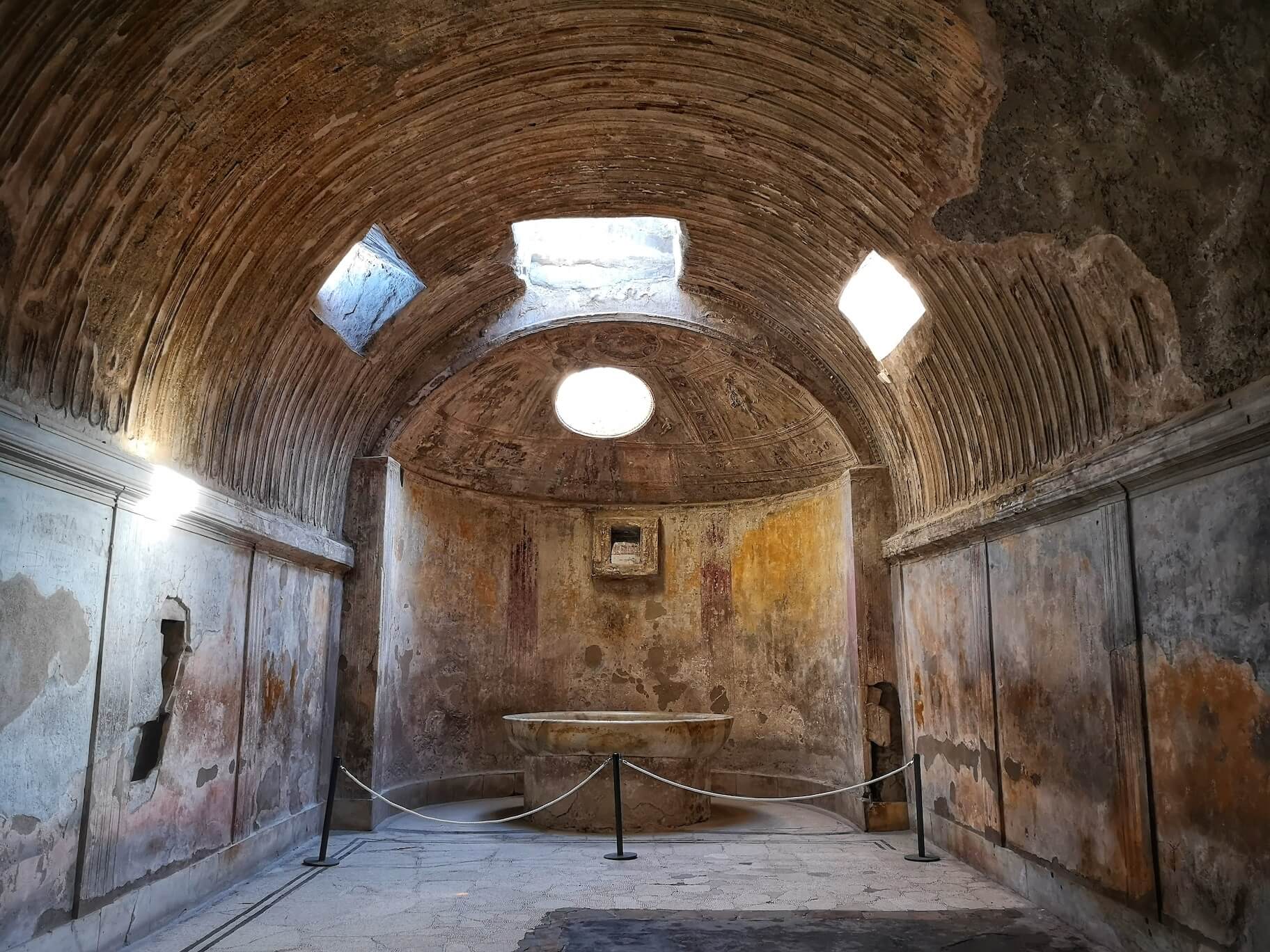 Communal baths were vitally important to the ancient Roman world as places both to bathe and socialise. Whilst only the richest citizens would have had private bathing facilities in their homes, public baths were open to all. In Pompeii two main complexes catered to the ablutions of the city’s residents: the large-scale Stabian Baths and smaller Forum Baths.
Communal baths were vitally important to the ancient Roman world as places both to bathe and socialise. Whilst only the richest citizens would have had private bathing facilities in their homes, public baths were open to all. In Pompeii two main complexes catered to the ablutions of the city’s residents: the large-scale Stabian Baths and smaller Forum Baths.
For many a trip to the Baths was a daily event, and a visit could last for hours. You might find yourself working up a lather doing some kind of exercise, or enjoying a massage. The cleansing process would encompass the application of oils that were scraped off with a strigil, before a visit to the tepidarium and caldarium - the hot and warm water rooms respectively. The bathing process would be completed with a bracing dip in the frigidarium, whose cold water was thought to soothe the muscles.
A must visit on a tour of Pompeii, the large Stabian Baths give a vivid insight into the scale of ancient Roman bath complexes, with its colonnaded palaestra (a gym where you would regularly find gladiators working out), swimming pools, changing rooms and baths devoted to both sexes. The Forum Baths for their part boast stunning interior decorations, with stucco reliefs and terracotta figures known as Telemones adorning the beautiful spaces where these vital ancient rituals took place.
The Forum of Pompeii
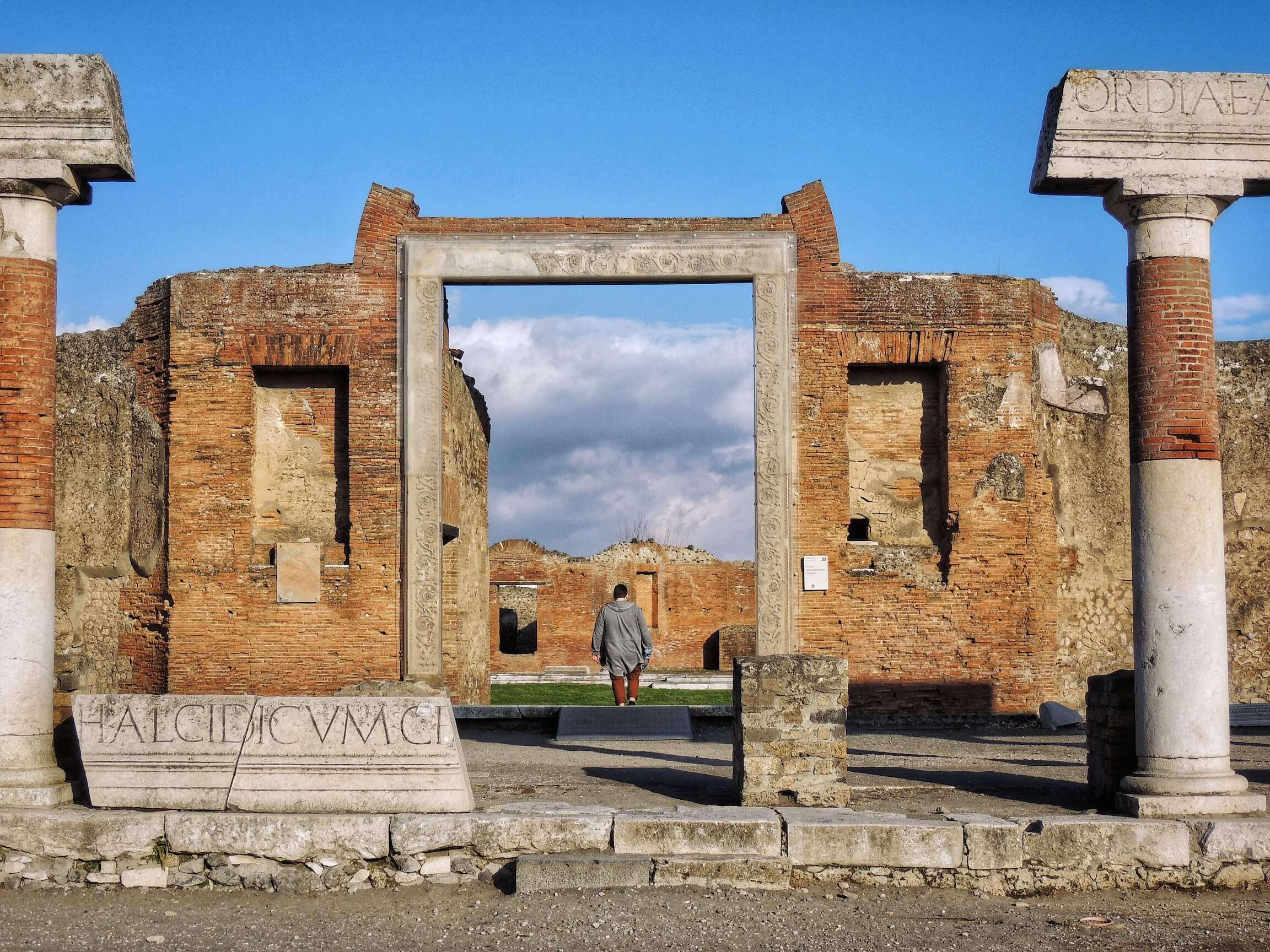 If you’ve visited Rome then it’s a safe bet that you’ve taken a stroll through the Roman Forum, the centre of civic, commercial and religious life in the ancient city. Other Roman settlements were similarly organised around a large central space, and the Forum of Pompeii is a particularly impressive example. The Forum would originally have been entirely paved with travertine, whilst a beautifully decorated colonnade would have closed off the area on all sides. Ancient citizens of Pompeii would have come to the Forum to visit the Forum Baths, or attended meetings of the city council in the Curia. The Basilica doubled as a court of law and marketplace, and many of Pompeii’s most significant temples were located here too - including the impressive temples of Vespasian, Apollo, Venus and Jupiter. The layout that we see today dates from between the 3rd and 2nd century BC, when the Forum was altered to centralise its focus on the Temple of Jupiter, magnificently framed by the foreboding outline of Mt. Vesuvius in the distance.
If you’ve visited Rome then it’s a safe bet that you’ve taken a stroll through the Roman Forum, the centre of civic, commercial and religious life in the ancient city. Other Roman settlements were similarly organised around a large central space, and the Forum of Pompeii is a particularly impressive example. The Forum would originally have been entirely paved with travertine, whilst a beautifully decorated colonnade would have closed off the area on all sides. Ancient citizens of Pompeii would have come to the Forum to visit the Forum Baths, or attended meetings of the city council in the Curia. The Basilica doubled as a court of law and marketplace, and many of Pompeii’s most significant temples were located here too - including the impressive temples of Vespasian, Apollo, Venus and Jupiter. The layout that we see today dates from between the 3rd and 2nd century BC, when the Forum was altered to centralise its focus on the Temple of Jupiter, magnificently framed by the foreboding outline of Mt. Vesuvius in the distance.
The Teatro Grande and Teatro Piccolo
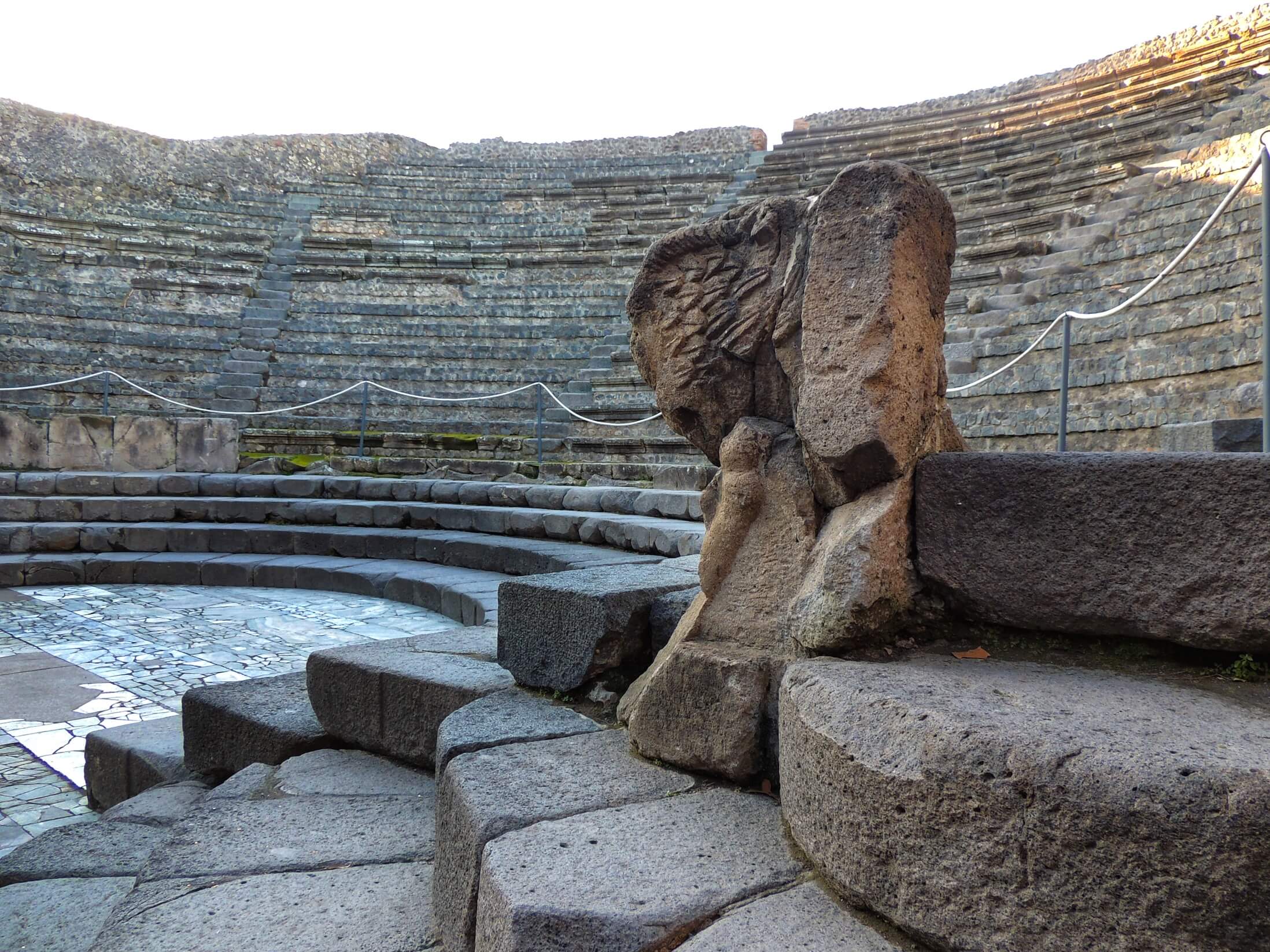 To get a sense of what ancient Pompeiians got up to in their spare time, make sure to make a visit to the city’s twin theatres: dating from the 2nd century BC, the semi-circular Teatro Grande (Large Theatre) was one of the first stone theatres in the Roman empire and could accomodate 5,000 spectators. It’s not hard to imagine them piling into its rows of marble stone seats (each numbered to allow for efficient access) to take in performances of classic Greek tragedies or ribald comedies as you wander through the structure today. Next door, the more intimate Teatro Piccolo (Little Theatre) would have been devoted to music concerts, and was one of the empire’s covered theatres.
To get a sense of what ancient Pompeiians got up to in their spare time, make sure to make a visit to the city’s twin theatres: dating from the 2nd century BC, the semi-circular Teatro Grande (Large Theatre) was one of the first stone theatres in the Roman empire and could accomodate 5,000 spectators. It’s not hard to imagine them piling into its rows of marble stone seats (each numbered to allow for efficient access) to take in performances of classic Greek tragedies or ribald comedies as you wander through the structure today. Next door, the more intimate Teatro Piccolo (Little Theatre) would have been devoted to music concerts, and was one of the empire’s covered theatres.
The Thermopolium of Via dell’Abbondanza
 Some aspects of ancient Roman life as preserved in Pompeii appear to us as startlingly modern, more than 2,000 years after the city’s untimely entombment. You’ll be sure to feel a shiver of recognition when you come across one of the city’s numerous thermopolia, the Roman equivalent of a fast food restaurant.
Some aspects of ancient Roman life as preserved in Pompeii appear to us as startlingly modern, more than 2,000 years after the city’s untimely entombment. You’ll be sure to feel a shiver of recognition when you come across one of the city’s numerous thermopolia, the Roman equivalent of a fast food restaurant.
A thermopolium typically had very distinctive features: a large doorway faced the street, where a counter laden with jars filled with food and wine would greet customers. Shrines dedicated to Bacchus, god of wine, and Mercury, god of commerce would bring prosperity to the establishment. In the swankiest thermopolia you would have found the menu beautifully painted on the wall, right behind the counter, to help you choose your meal. In a poignant reminder of the swift and brutal fate that overcame Pompeii, the unclaimed money of the tavern’s final customer was discovered lying on the counter.
House of Menander
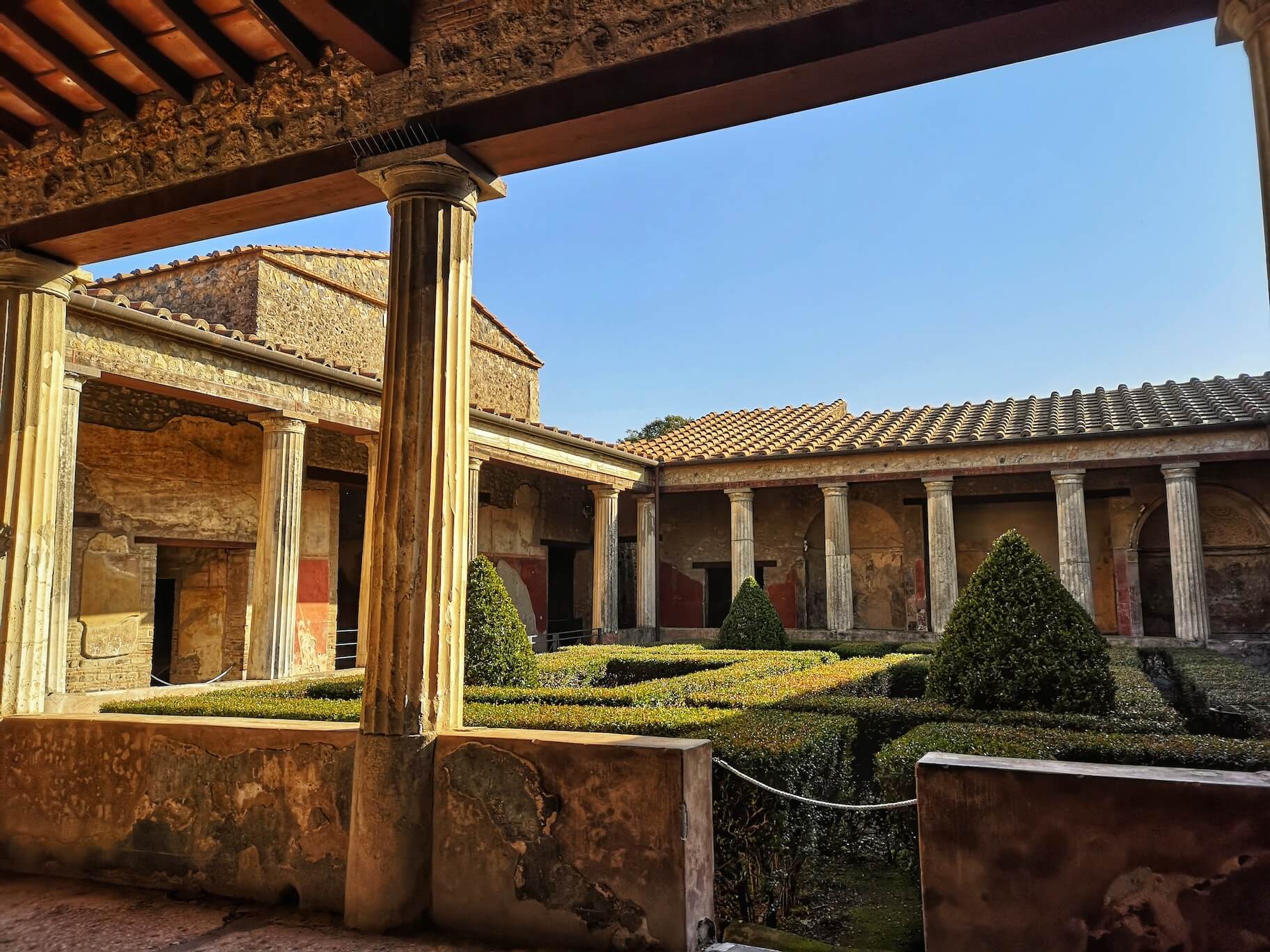
The magnificent House of Menander was one of the largest and most complex private houses in ancient Pompeii. Decorated within with extraordinary frescoes portraying scenes from Homer’s Odyssey, the structure takes its name from a painting of the Greek playwright Menander located in the portico. The magnificent peristyle courtyard enclosed by Doric columns is one of the most evocative corners of the entire archaeological site. Look out too for the shrine decorated to the household gods known as lares, guardian deities who protected the family and household in return for regular maintenance of their shrine.
The Amphitheatre
The oldest Roman amphitheatre that we know of, Pompeii’s amphitheatre was first built in 70 BC under the auspices of the magistrates Caius Quinctius Valgus and Marcus Porcius, and predates the Colosseum by more than a century. With a capacity upwards of 20,000 people, there was space for almost half of Pompeii’s population in the amphitheatre, giving a sense of its central importance to life in the city.
As with the Roman Colosseum, the amphitheatre played host to gladiator combats, animal hunts and exotic performances of all kinds on feast days. During a notorious games in 59 AD a fully fledged riot erupted in the stands, leading to an order closing the amphitheatre for 10 years. Although it was ultimately reopened after just 3, the amphitheatre’s reprieve was short-lived - less than 2 decades later the eruption of Vesuvius would ensure that the amphitheatre would be silenced forever. That is, at least, until Pink Floyd would bring the arena temporarily back to life with an iconic concert held here in 1972.
The Lupanar (Brothel)
Ancient Romans had a typically frank relationship with sex, and prostitution was an established and accepted part of daily life in antiquity. Pompeii’s brothel was a 2-storey affair, with the lower floor given over to five small rooms with beds (still visible today) where the clients would meet the prostitutes, and the upper level reserved for the sleeping quarters of the proprietor and employees. In Latin a brothel was known as a lupanar, deriving from the slang term for prostitutes in ancient Rome - lupa, or she-wolf. Pompeii’s lupanar is particularly fascinating for the series of frescoes depicting various sexual positions lining the establishment’s entrance wall, a particualrly efficacious way for visitors to choose what they wanted. Look out for the phallic charms in the pavement outside, presumably auguring vim and potency for the arriving clients.
Check out Part 2 of our Illustrated Guide to Pompeii here, where we'll be continuing the story of the city frozen in time with Pompeii's most opulent villas, ancient temples and more.



